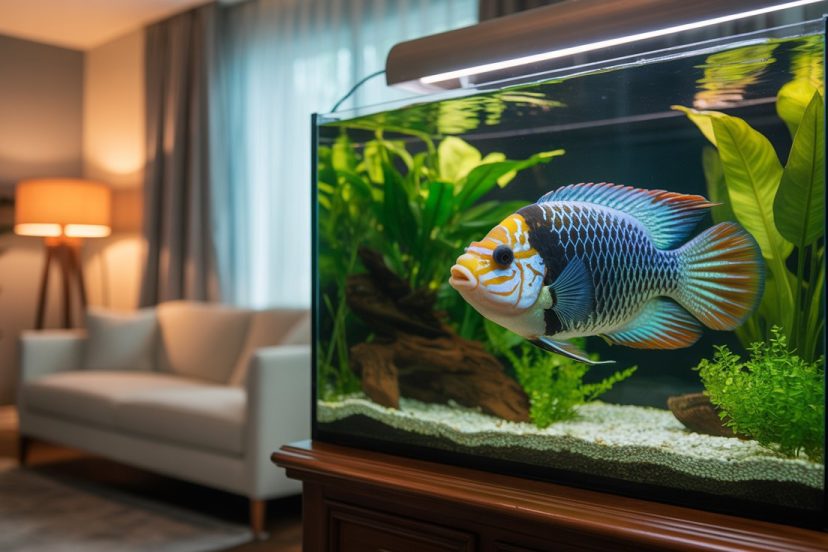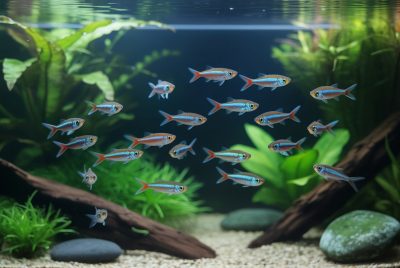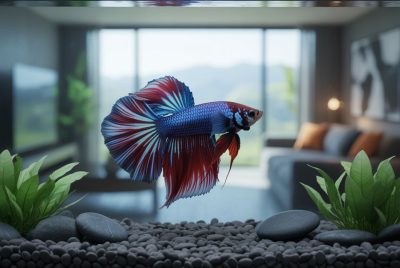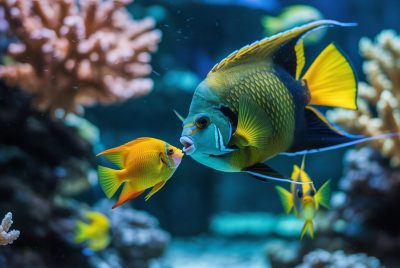Oscar Fish Care: Ultimate Tank Setup and Feeding Guide
*We may earn a commission for purchases made using our links. Please see our disclosure to learn more.
Oscar fish, scientifically known as Astronotus ocellatus, are among the most beloved yet challenging freshwater aquarium fish in the hobby. These South American cichlids captivate aquarists with their striking appearance, remarkable intelligence, and dog-like personalities that make them seem more like aquatic pets than mere fish. However, their impressive size, aggressive temperament, and specific care requirements demand serious commitment from their keepers.
Understanding proper Oscar fish care is crucial for anyone considering these magnificent creatures. These fish can grow up to 18 inches in length and live for 10-20 years when provided with optimal conditions. Their natural habitat in the Amazon River basin provides important clues about creating the perfect aquarium environment that will allow these impressive cichlids to thrive in captivity.
“Oscars are not just fish; they’re aquatic companions that recognize their owners, beg for food, and display complex behaviors that rival many terrestrial pets.”
– American Cichlid Association Research Journal
Key Takeaways
- Tank Size: Minimum 75 gallons for one Oscar, 125+ gallons for multiple fish
- Water Parameters: Temperature 74-81°F, pH 6.0-8.0, soft to moderately hard water
- Diet: High-protein carnivorous diet with variety including pellets, frozen foods, and occasional live prey
- Tankmates: Limited options due to size and aggression; compatible with other large South American cichlids
- Lifespan: 10-20 years with proper care and optimal conditions
- Personality: Highly intelligent, interactive fish that develop strong bonds with owners
Recommended Oscar Fish Products
1. Fluval FX6 High Performance Aquarium Canister Filter
The Fluval FX6 High Performance Aquarium Filter is designed to handle large aquariums up to 400 gallons, offering advanced filtration for crystal-clear water. With a powerful pump that delivers 925 gallons per hour, this filter ensures optimal water quality for your aquatic environment. Featuring Smart Pump technology, it automatically adjusts to deliver top-notch performance, evacuating trapped air every 12 hours to maintain efficiency. Its self-starting system makes setup a breeze—simply add water, plug it in, and let Smart Pump do the rest. The FX6 includes removable, stackable media baskets that eliminate water bypass and hold up to 1.5 US gallons of media for mechanical, chemical, and biological filtration. With an easy-to-use design and included filter media, this canister filter offers superior filtration for a healthier aquarium.
In this Oscar Fish Care Guide, filtration is one of the most critical factors for maintaining water quality in large aquariums. Oscars produce significant waste, making a strong and reliable filter essential. The Fluval FX6 Canister Filter is a top choice among experienced aquarists because of its high flow rate and multi-stage filtration system. It not only handles large tanks up to 400 gallons but also uses Smart Pump Technology to maintain peak performance. For Oscar keepers looking to reduce maintenance time while ensuring clean, healthy water, the FX6 is one of the best filtration solutions available.
- Powerful filtration: Pumps 925 gallons of water per hour, ensuring efficient water circulation for large tanks.
- Smart Pump technology: Continuously monitors and optimizes pump performance for maximum efficiency.
- User-friendly design: Self-starting system with easy water changes, no need to lift heavy buckets.
- Large size: The compact design is still tall, so it may not fit under all aquarium stands.
- Initial cost: At $369.99, it may be a higher upfront investment for aquarium owners.
- Maintenance: While user-friendly, the filter requires regular maintenance to keep optimal performance.
2. Hikari Cichlid Gold Large Pellets
Give your Oscars the nutrition they need with Hikari Cichlid Gold Floating Pellets. Specially formulated to enhance natural color, these large pellets provide a balanced diet that supports growth, vitality, and overall health. Floating design encourages surface feeding, making mealtime easy and mess-free. A trusted choice for cichlid owners, this food is ideal for Oscars and other large freshwater fish.
In this Oscar Fish Care Guide, quality nutrition is one of the most important factors for keeping your fish healthy and thriving. A popular choice among aquarists is the Hikari Cichlid Gold Floating Pellets. These pellets are designed for large cichlids like Oscars, offering balanced nutrition and natural color enhancement. Since Oscars are messy eaters, the floating design helps minimize waste while encouraging natural feeding behavior. Adding Hikari Cichlid Gold to your care routine supports both the health and beauty of your Oscar fish, making it a staple in many aquariums.
- Nutrition: Packed with essential nutrients for Oscar growth and vitality
- Color Enhancement: Promotes vibrant, natural coloration in your fish
- Convenience: Floating pellets reduce tank waste and are easy to feed
- Size: Large pellets may not suit smaller cichlids or young Oscars
- Price: Higher cost compared to generic fish foods
- Availability: May be harder to find in smaller local stores
3. EHEIM Jager Aquarium Thermostat Heater 300W
The Eheim Jager 300W Aquarium Heater is designed to keep tanks between 159–264 gallons at a stable temperature. Fully submersible and made from shock-resistant, shatterproof glass, it offers reliable performance for both freshwater and marine setups. Features include an automatic shut-off when water is too low, thermo safety control to prevent overheating, and an easy-to-read on/off indicator light. Perfect for large tanks housing temperature-sensitive fish like Oscars.
In this Oscar Fish Care Guide, maintaining stable water temperature is a key factor in keeping your fish healthy and stress-free. Oscars thrive in consistent, warm conditions, which is why the Eheim Jager 300W Aquarium Heater is a trusted choice among aquarists. Built with shatterproof glass and advanced safety features, it automatically shuts off if water levels drop too low. With its high wattage, this heater is powerful enough for large tanks where Oscars are commonly kept. Reliable heating ensures your Oscars stay comfortable, active, and free from temperature-related stress.
- Safety: Thermo safety control prevents overheating and damage when running dry
- Durability: Shatterproof glass ensures long-lasting, reliable use
- Capacity: Ideal for large aquariums up to 264 gallons
- Size: At 20” long, may be difficult to fit in smaller setups
- Precision: Temperature calibration may require fine-tuning
- Visibility: Indicator light is small and can be hard to see in darker rooms
4. API Freshwater Master Test Kit
The API Freshwater Master Test Kit is a comprehensive and trusted solution for monitoring the health of your freshwater aquarium. With the ability to perform up to 800 tests, this kit includes everything you need: 7 bottles of testing solutions, 4 test tubes with caps, and a detailed color chart for accurate readings. It measures five critical water parameters—pH, high-range pH, ammonia, nitrite, and nitrate—ensuring your betta fish lives in clean, safe, and stable water conditions. Regular use of this kit helps prevent invisible water issues that can lead to stress, disease, or even loss of your fish.
In this Oscar Fish Care Guide, water quality is one of the most important aspects of keeping your fish healthy. Oscars are sensitive to poor water conditions, and high ammonia or nitrate levels can quickly cause stress or disease. The API Freshwater Master Test Kit is a must-have for any Oscar keeper, allowing you to accurately monitor pH, ammonia, nitrites, and nitrates on a weekly basis. With up to 800 tests included, it provides excellent value and ensures you can stay on top of your aquarium’s water quality. Regular testing is key to preventing hidden issues and maintaining a thriving environment for your Oscars.
- Comprehensive Testing: Covers all essential water parameters for freshwater tanks.
- Long-Lasting Value: Provides up to 800 tests, making it cost-effective over time.
- Accurate Results: Trusted by hobbyists and professionals for precise water readings.
- Manual Process: Requires measuring and comparing to color charts, which can be time-consuming.
- Storage Space: Comes in a relatively bulky box that may take up tank cabinet space.
- No Digital Display: Lacks digital convenience some modern testers offer.
Understanding Oscar Fish Behavior and Characteristics
Oscar fish possess remarkable intelligence that sets them apart from most aquarium inhabitants. These cichlids demonstrate complex behaviors including territory establishment, problem-solving abilities, and even learned feeding responses. Many experienced aquarists report their Oscars recognizing individual people, showing excitement during feeding times, and displaying what can only be described as personality traits.
The natural aggression of Oscar fish stems from their territorial nature in the wild. In their native South American waters, Oscars establish and defend territories along riverbanks and in slow-moving tributaries. This instinct remains strong in captivity, making tankmate selection a critical consideration for successful Oscar keeping.
Physical characteristics of healthy Oscars include vibrant coloration, alert behavior, and steady swimming patterns. Wild-type Oscars display dark bases with orange and red markings, while captive-bred varieties showcase stunning color mutations including albino, tiger, and red varieties. Understanding these natural traits helps aquarists recognize signs of health and stress in their fish.
Essential Tank Setup Requirements
Tank Size and Dimensions
The most common mistake new Oscar owners make involves underestimating space requirements. A single adult Oscar requires a minimum of 75 gallons, though 100+ gallons provides significantly better conditions. For multiple Oscars or community setups, tanks should start at 125 gallons and increase by 75 gallons for each additional Oscar.
Tank dimensions matter as much as volume. Oscars appreciate horizontal swimming space, making long, rectangular tanks preferable to tall, narrow designs. A 6-foot tank length provides adequate territory for adult Oscars while allowing for proper filtration placement and maintenance access.
Filtration Systems
Oscar fish produce substantial waste, requiring robust filtration systems capable of handling high bioloads. Canister filters offer superior biological and mechanical filtration for Oscar tanks, with flow rates of 8-10 times the tank volume per hour being ideal. Multiple filtration methods, including canister filters combined with powerheads or additional mechanical filtration, create optimal water conditions.
Biological filtration becomes particularly important in Oscar tanks due to their messy eating habits and waste production. Establishing and maintaining beneficial bacteria colonies through proper filter media and regular maintenance prevents dangerous ammonia and nitrite spikes that can quickly become lethal.
Heating and Temperature Control
Maintaining stable temperatures between 74-81°F proves crucial for Oscar health and immune system function. Quality aquarium heaters sized appropriately for tank volume, typically 5 watts per gallon, provide consistent heating. Backup heaters offer insurance against equipment failure, which can quickly prove fatal in large tanks.
Temperature fluctuations stress Oscars and compromise their immune systems, making them susceptible to diseases like ich and bacterial infections. Monitoring equipment including reliable thermometers helps maintain the stable conditions these fish require for long-term health.
Water Quality and Parameters
pH and Hardness Requirements
Oscar fish demonstrate remarkable adaptability to various water parameters, thriving in pH ranges from 6.0-8.0 and soft to moderately hard water conditions. However, stability proves more important than achieving perfect numbers. Sudden parameter changes stress fish far more than slightly suboptimal but stable conditions.
Water changes of 25-30% weekly help maintain stable parameters while removing accumulated nitrates and other waste products. Using dechlorinated water matched to tank temperature prevents shock and maintains the delicate balance of established aquarium ecosystems.
Ammonia, Nitrite, and Nitrate Management
The nitrogen cycle forms the foundation of successful Oscar keeping. Ammonia and nitrite levels must remain at zero, while nitrates should stay below 40 ppm through regular water changes and proper filtration. Oscar tanks can experience rapid parameter shifts due to high waste production, making frequent testing essential.
Establishing proper biological filtration before adding Oscars prevents dangerous new tank syndrome. Cycling tanks properly using ammonia sources or hardy fish creates stable bacterial colonies capable of processing Oscar waste loads effectively.
Feeding Your Oscar Fish
Nutritional Requirements
Oscar fish require high-protein diets reflecting their carnivorous nature in the wild. Quality cichlid pellets should form the dietary foundation, supplemented with frozen foods like bloodworms, brine shrimp, and krill. Variety prevents nutritional deficiencies and maintains feeding interest in these intelligent fish.
Feeding frequency depends on fish age and size. Juvenile Oscars benefit from 2-3 small meals daily, while adults thrive on once-daily feeding or every other day schedules. Overfeeding represents one of the most common Oscar keeping mistakes, leading to water quality issues and health problems.
Live and Frozen Food Options
While not essential, live foods can enhance Oscar coloration and provide enrichment. Feeder fish carry disease risks and offer poor nutritional value, making them less desirable than safer alternatives like earthworms, crickets, or frozen foods that provide similar nutritional benefits without health risks.
Frozen foods offer convenience and safety while maintaining nutritional value. Bloodworms, mysis shrimp, and krill provide excellent supplementation to commercial diets. Thawing frozen foods before feeding improves digestibility and prevents digestive issues.
Foods to Avoid
Several common foods prove harmful or inadequate for Oscars. Goldfish and other fatty feeder fish can cause liver problems and carry diseases. Mammalian meats lack proper nutrients and can cause digestive issues. Foods high in fillers or artificial colors provide poor nutrition and may cause long-term health problems.
Compatible Tankmates for Oscars
Large South American Cichlids
The best Oscar tankmates share similar origins, size requirements, and temperaments. Other large South American cichlids like Green Terrors, Jack Dempseys, and Severums can coexist with Oscars in sufficiently large tanks. These species understand cichlid communication and territorial behaviors, reducing conflict potential.
Successful mixed cichlid communities require careful planning and adequate space. Each species needs sufficient territory, with tank decorations creating visual barriers and separate areas. Introducing tankmates simultaneously or adding Oscars last often improves compatibility outcomes.
Non-Cichlid Options
Large catfish species like Common Plecos, Royal Plecos, or Sailfin Plecos can work with Oscars due to their size, armor plating, and different habitat preferences. These bottom-dwellers occupy different tank areas and provide beneficial algae control services.
Some aquarists successfully keep large, fast-swimming fish like Silver Dollars or Bichirs with Oscars. These combinations require expert-level aquarium management and may not work in all situations, depending on individual fish personalities and tank dynamics.
Fish to Avoid
Small fish of any species become expensive live food for hungry Oscars. Aggressive species that might damage Oscar eyes or fins, such as Red Devil Cichlids or Piranha species, create dangerous situations. Delicate fish requiring pristine water conditions cannot tolerate the bioload and water parameters of Oscar tanks.
Tank Decoration and Environment
Substrate Choices
Sand or fine gravel substrates work best for Oscars, allowing natural digging behaviors while preventing injury. These fish frequently rearrange substrate and decorations, making heavy, stable elements essential for tank safety. Bare bottom tanks simplify maintenance but reduce natural behavior expression.
Substrate depth of 2-3 inches accommodates digging while maintaining biological filtration in the substrate layer. Regular substrate vacuuming removes accumulated waste and prevents anaerobic zones that can produce harmful gases.
Plants and Decorations
Live plants face constant uprooting from territorial Oscars, though some aquarists succeed with hardy species like Anubias or Java Fern attached to decorations. Artificial plants offer similar benefits without replacement costs, though they require regular cleaning to prevent algae accumulation.
Decorations should be sturdy and heavy enough to resist Oscar rearrangement attempts. Caves, driftwood, and rock formations provide territory definition and stress reduction. Smooth surfaces prevent injury during the inevitable redecoration sessions these fish perform.
Common Health Issues and Prevention
Disease Recognition
Early disease detection significantly improves treatment outcomes for Oscars. Common symptoms include appetite loss, color changes, unusual swimming patterns, or visible spots and lesions. Healthy Oscars display vibrant colors, alert behavior, and steady swimming patterns.
Stress often precipitates disease outbreaks in Oscars. Maintaining stable water parameters, providing adequate space, and ensuring proper nutrition build strong immune systems that resist common aquarium diseases.
Preventive Care
Quarantine periods for new fish prevent disease introduction to established tanks. A separate 40-gallon quarantine tank allows observation and treatment of new arrivals before introducing them to main displays. This practice prevents devastating disease outbreaks that can affect entire tank populations.
Regular water testing and maintenance prevent most health issues before they develop. Weekly parameter testing, consistent water changes, and filter maintenance create stable environments where healthy fish thrive.
Breeding Oscar Fish
Sexual Determination
Determining Oscar sex requires patience and observation skills. Males typically develop more pointed dorsal and anal fins, while females remain rounder in body shape. During breeding condition, both sexes develop breeding tubes, with females showing broader, more rounded tubes compared to males’ narrower, more pointed versions.
Behavioral differences become apparent during breeding seasons. Males establish and defend territories more aggressively, while females show preference for specific spawning sites. These behaviors help identify pairs within groups of fish.
Breeding Setup
Successful Oscar breeding requires dedicated tanks of at least 100 gallons with stable conditions and appropriate spawning surfaces. Flat stones, ceramic tiles, or specially designed spawning cones provide suitable egg-laying sites that parents can clean and defend.
Water temperature elevation to 82-84°F often triggers breeding behavior in established pairs. Consistent feeding with high-protein foods and frequent water changes maintain breeding condition and encourage spawning attempts.
Fry Care
Oscar parents provide excellent care for eggs and fry when conditions allow natural breeding behavior. However, many aquarists remove eggs or fry for artificial rearing to prevent predation and improve survival rates. Newly hatched fry require microscopic foods like infusoria or commercially prepared fry foods.
Fry grow rapidly under proper conditions, requiring frequent feeding and excellent water quality. Separating fry by size prevents cannibalism as growth rates vary significantly among siblings.
Long-term Oscar Care Considerations
Tank Maintenance Routines
Consistent maintenance schedules prevent problems and maintain healthy environments for long-lived Oscars. Weekly water changes, monthly deep cleaning sessions, and quarterly equipment inspections catch issues before they become serious problems.
Documentation of water parameters, feeding schedules, and fish behavior helps identify patterns and potential problems. Many experienced Oscar keepers maintain logs tracking their fish’s health and tank conditions over time.
Lifecycle Planning
Oscar longevity requires long-term planning for their 10-20 year lifespans. Tank upgrades, equipment replacement, and care arrangements during owner absences need consideration when committing to these long-lived fish.
Planning for size increases as Oscars grow helps prevent overcrowding situations. Young Oscars purchased for smaller tanks will quickly outgrow inadequate housing, requiring upgrades or rehoming decisions.
Conclusion
Caring for Oscar fish represents both a significant commitment and an incredibly rewarding experience for dedicated aquarists. These remarkable cichlids offer personality, intelligence, and longevity that few other freshwater fish can match. However, their size, aggression, and specific care requirements demand serious consideration before purchase.
Success with Oscars depends on providing adequate space, maintaining excellent water quality, offering proper nutrition, and understanding their complex behavioral needs. Those willing to meet these requirements discover why Oscars have maintained their popularity among aquarium enthusiasts for decades.
The journey of Oscar ownership teaches valuable lessons about aquatic ecosystems, fish behavior, and the rewards of dedicated animal care. These magnificent fish repay proper care with years of companionship and endless fascination for those committed to meeting their needs.
Remember that each Oscar develops its own personality and preferences. Observing individual fish behavior and adjusting care accordingly creates the strongest foundation for long-term success. With proper preparation and commitment, Oscar fish provide unmatched aquarium experiences that justify their demanding care requirements.
Frequently Asked Questions
Q: How long do Oscar fish typically live in aquariums?
A: Oscar fish can live 10-20 years in properly maintained aquariums with optimal water conditions, adequate space, and proper nutrition. Some exceptional specimens have been reported living even longer with expert care.
Q: Can Oscar fish live alone, or do they need companions?
A: Oscars can live alone successfully and often display less aggressive behavior in solitary setups. However, they can also thrive with appropriate tankmates in sufficiently large aquariums. The decision depends on tank size, owner experience, and individual fish personality.
Q: What size tank does a full-grown Oscar actually need?
A: A single adult Oscar requires a minimum of 75 gallons, though 100+ gallons provides significantly better conditions. For multiple Oscars, start with 125 gallons and add 75 gallons for each additional fish to prevent territorial conflicts and maintain water quality.
Q: How often should I feed my Oscar fish?
A: Adult Oscars should be fed once daily or every other day, while juveniles benefit from 2-3 smaller meals per day. Overfeeding is more harmful than underfeeding and can lead to water quality issues and health problems.
Q: Are Oscar fish really as intelligent as people claim?
A: Yes, Oscars demonstrate remarkable intelligence including recognizing individual owners, learning feeding routines, solving simple problems, and displaying distinct personalities. Many owners report their Oscars responding to their presence and showing excitement during interaction times.













